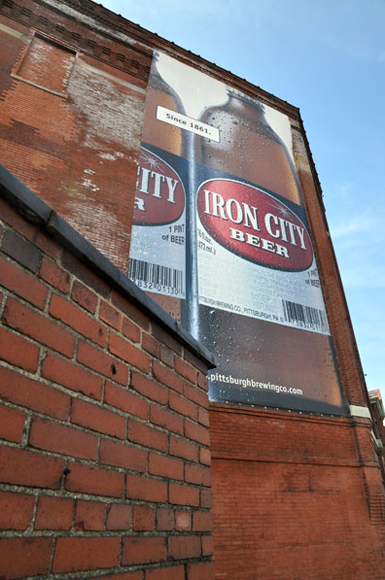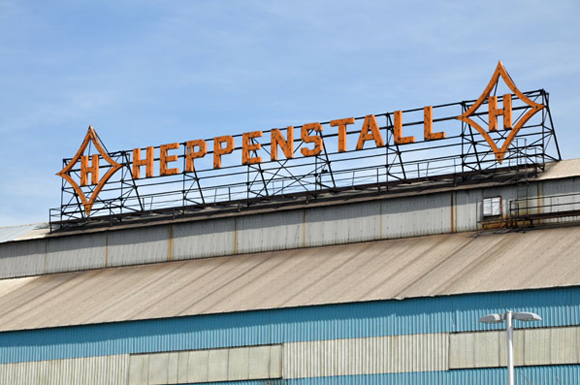If you haven’t been paying much attention to East Liberty, now’s the time to start. Between this article and a powerful video from Pop City Media last week, the neighborhood has been making the rounds in the local news scene, and with good reason. There are a lot of creative people working in East Liberty, and their enthusiasm is sparking a sort of neighborhood revival. Check out the article below to see what they’re doing.

(Waffle Shop)
FOOD FOR THOUGHT
When artist Jon Rubin moved to Pittsburgh in 2006 to teach at Carnegie Mellon University, he decided to experiment with some of the local materials: cheap real estate and good people. "Midwestern culture values openness and community engagement," he observes. Three years ago, he rented a storefront in the city's emerging East Liberty district for $500 a month and opened Waffle Shop, a place where hip locals can enjoy breakfast fare at all hours while participating in Web-streamed talk shows covering topics from "Michael Jackson and Teabaggers" to "Dolphin Breeding in Appalachia." The following year Rubin and artist Dawn Weleski turned the space next door into Conflict Kitchen, whose rotating menu draws from countries that the U.S. government has a political beef with—like Iran or Venezuela—helping expand the community's culinary and cultural consciousness. As Rubin says: "We're creating the place where we want to live now."
•••

(Sam Franklin, executive director of the Office of Teacher Effectiveness)
THE PUBLIC-EDUCATION MAVERICK
In 2006, when the Steel City's Mayor Luke Ravenstahl and Pittsburgh Public Schools superintendent Mark Roosevelt issued the "Pittsburgh Promise"—that all the city's qualified high-school graduates could receive financial help to attend college—Sam Franklin was still a Carnegie Mellon grad student. Today, as the executive director of the two-year-old Office of Teacher Effectiveness, the Maryland native is trying to ensure that every one of the city's graduates is qualified, with a raft of techniques to evaluate and encourage teachers, funded in part by a $40 million grant from the Bill & Melinda Gates Foundation. These include financial incentives and promotions for high performers. "We've historically treated—and compensated—all teachers similarly, regardless of their actual effectiveness," Franklin, 31, explains. Pittsburgh's unique character makes it an ideal springboard for broader reform, he adds. "The city is modest enough that you can actually get things done," he says, "but big enough so they can truly matter on a national level."
•••

(One of Grow Pittsburgh's urban farms)
THE STEEL CITY'S GRAY GARDENS
Developers are gradually rebuilding Pittsburgh's blighted areas, but more than 20,000 vacant lots remain. Since its founding in 2005, Grow Pittsburgh has been turning these plots into community gardens and urban farms, providing summer internships for kids and health education for all—not to mention food: The organization helps distribute produce to low-income kitchens and works with local chefs to place its lettuce and leeks in high-end restaurants.
•••
THE URBAN REPURPOSERS
The husband-and-wife-led architecture firm EDGE Studio is driving a renaissance in Pittsburgh's skyline by way of imaginative renovations. Its 2010 expansion of the East Liberty branch of the Carnegie Library used a rain-screen exterior to give the staid Nixon-era institutional building unexpected sculptural flourishes, while last year's Wigle Whiskey distillery turned a bleak warehouse into a glowing space with chandeliers made of whiskey bottles.
•••
THE ART HUB OF THE FUTURE
Yes, it's the cornerstone of the soon-to-boom Penn Ave Arts District, but Assemble is more than a gallery. The year-old space feels more like an informal classroom where visitors come for the interactive, tech-focused art, then stay for the hacker workshops, PechaKucha presentations, and dance parties. Built by Nina Marie Barbuto, a native Pittsburgher who returned after a stint in L.A., as a hub for aspiring creatives, Assemble is a place for first drafts, manifestos, artistic experimentation—paint the walls, break out the solder guns. In Pittsburgh, Barbuto observes, "You don't need much to make things happen."
•••

(Jeremy Kulousek (seated) and Eric Dan (right) of ID Labs)
HIP-HOP'S NEW HIT-MAKERS
Detroit has always had Motown, and Cleveland is home to the Rock and Roll Hall of Fame, but unlike its fellow Rust Belt cities, Pittsburgh has never been much of a music mecca. Until, that is, hometown hero Wiz Khalifa's "Black and Yellow" became the city's de facto anthem during the Steelers' 2010-2011 Super Bowl run. The guys behind the rapper are Eric Dan (a.k.a. E. Dan), 35, who launched ID Labs as a recording studio in 2003, and Jeremy Kulousek (a.k.a. Big Jerm), 26, who joined him three years later. Around the same time, a teenage Khalifa scored an internship answering phones and sweeping floors, which eventually led to a fruitful collaboration: ID Labs produced (and Dan cowrote) about half the songs on Khalifa's hit album Rolling Papers. For the past few years, the duo have been working with other local hip-hop talent, including Mac Miller (whose viral hit "Donald Trump" has 52 million YouTube views and counting), Boaz, and Khalifa's protégé Chevy Woods. Despite pressure to move to one of the coasts, Dan insists that ID Labs is staying put: "We enjoy being outside the fray."
•••

(Matthew Ciccone at the Beauty Shoppe)
THE IDEA INCUBATOR
Creative entrepreneurship is booming in post-industrial Pittsburgh, and Matthew Ciccone is a major reason why. After stints working in New York City and Chicago, the 32-year-old developer returned to his hometown to attend graduate school in urban design and public policy at Carnegie Mellon University, then in 2009 launched the boutique real-estate company Edile, which caters to the nascent arts and high-tech industries in the fast-emerging neighborhood of East Liberty. Last year, he opened the Beauty Shoppe, a sleek coworking space for fledging start-ups who've outgrown the tables at Starbucks: In fact, the price of a desk—$9 a day with a monthly membership—is based on the cost of three lattes, says Ciccone (if the name sounds familiar, it's because he's a distant cousin of that slightly more famous Ciccone, Madonna). Next up: a second, larger Beauty Shoppe location, as well as a different kind of shared workspace aimed at small manufacturers—anyone from roboticists to whiskey distillers, according to Ciccone—who need somewhere to produce their products. Ciccone is also partnering with the Ace Hotel to open a local outpost in 2014 in a vacant century-old YMCA building. "It's a rare opportunity," he says, "to shape a city where you actually live and hope to raise a family."
•••
Know This Neighborhood: East Liberty, Pittsburgh
In barely a decade, Sliberty, as the locals call it, has gone from an industrial wasteland to Pittsburgh's answer to Silicon Valley. Two years ago it improbably became home to a major Google office, and half a dozen tech start-ups have followed suit.
THE TOP SPOTS
Dinette: High-end pizza with ingredients from the roof garden.
5996 Penn Circle South, 412-362-0202 ; dinette-pgh.com
Shadow Lounge: A neighborhood nightlife institution, with hip-hop DJs, parties, and film screenings.
5972 Baum Blvd., 412-363-5248 ; shadowlounge.net
Waffle Shop and Conflict Kitchen: 124 S. Highland Ave., 724-681-3886 ; waffleshop.org, conflictkitchen.org
Zeke's Coffee: Its small-batch roasts are served gratis to tenants of the Beauty Shoppe.
6012 Penn St., 412-670-6231 ; zekescoffeepgh.com
FACT: Pittsburgh is America's most livable city, according to the Economist Intelligence Unit, thanks to lifestyle factors like culture, education, and infrastructure.
Read More http://www.details.com/culture-trends/critical-eye/201204/rust-belt-revival-pittsburgh-pennsylvania#ixzz1r5HoyTK6


















